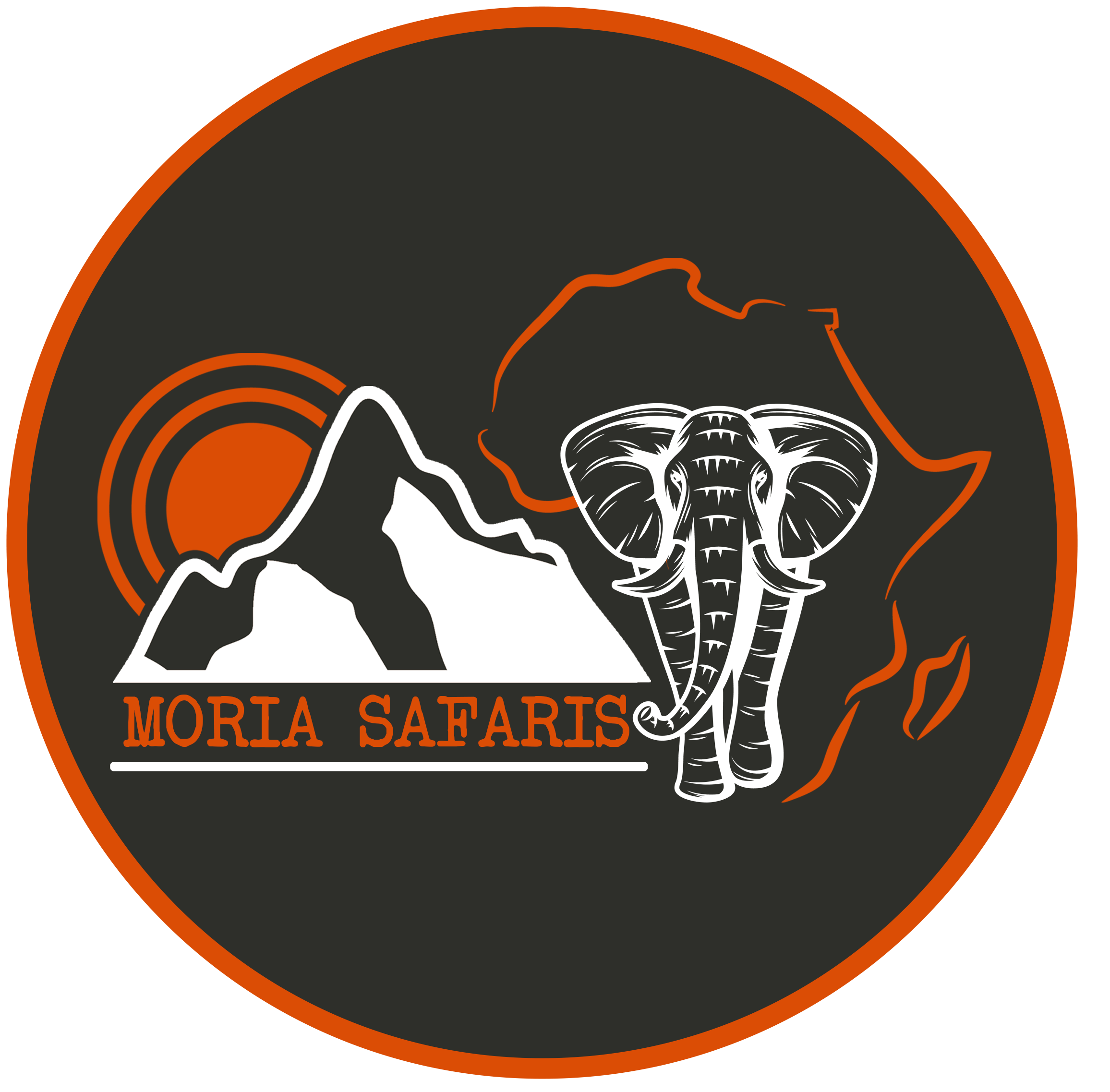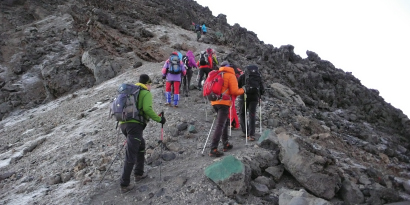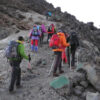Effective Planning is Key
A journey up Mount Kilimanjaro is an extraordinary adventure, distinct from typical vacations or casual hikes. Climbing this majestic peak demands meticulous preparation. After all, this expedition leads hikers to the summit of Africa at 5,895 meters (19,340 feet) above sea level, an altitude many may never have experienced before. It truly embodies the adventure of a lifetime.
Kilimanjaro expeditions come with inherent risks associated with high altitudes. These challenges underscore the importance of having professional guides and proper equipment. Without these crucial elements, the safety of the hiking party is compromised.
It’s important to emphasize that appropriate gear is paramount. Climbing Kilimanjaro requires specialized equipment; your usual hiking attire won’t suffice.
Considerations to Remember in Preparing for this Thrilling African Expedition Undertaking this exhilarating adventure in the heart of Africa requires attention to several significant aspects. In this article, we’ve condensed essential recommendations to ensure a successful and seamless Kilimanjaro expedition.
Opt for Extended Itineraries for Your Journey
You’ve likely come across a variety of Kilimanjaro itineraries online, ranging from concise 5-day treks to more extensive 7, 8, or even 10-day adventures with the possibility of Crater Camping. It may be tempting to opt for a shorter itinerary, especially when they all ultimately lead you to the pinnacle of Africa. So, what’s the rationale behind investing more time and resources on the slopes of Kilimanjaro?
There are two primary reasons for considering longer itineraries:
- Enhanced Acclimatization: As you ascend higher during your trek, the oxygen saturation level in the air gradually decreases. This phenomenon occurs due to the reduction in atmospheric pressure, which causes oxygen molecules to disperse. Essentially, every breath you take at higher altitudes provides your body with less oxygen. However, your body can adapt to this challenge through intensified and deeper breathing, as well as expedited oxygen transportation by red blood cells and other physiological adjustments. Nevertheless, this transformation necessitates time and energy. Hence, spending more time on the mountain is crucial for effective acclimatization.
- Altitude Sickness Mitigation: Rushing up Kilimanjaro without allowing sufficient time for acclimatization increases the risk of altitude sickness. This condition may necessitate a return to lower altitudes before you can successfully reach the summit of Kilimanjaro.
Furthermore, extended itineraries offer superior opportunities for savoring the breathtaking scenery that Kilimanjaro has to offer. When hurrying to reach the next camp before nightfall, you might inadvertently bypass the most picturesque regions of the mountain. Kilimanjaro is undeniably one of the most stunning places on Earth, and lingering on the Shira Plateau or Barranco Wall to relish the remarkable vistas or taking a leisurely break with friends in the midst of your journey between camps is a true delight. Ascending the highest peak in Africa is a once-in-a-lifetime experience, and rushing through it may not be the most fulfilling way to relish this incredible opportunity. Indeed, when you consider the investment involved in a Kilimanjaro climb, the distinction between a 6-day and 7-day trek is marginal, but the difference in your overall experience and adventure is substantial. A longer itinerary not only provides a more rewarding experience but also enhances safety, allowing you to truly revel in Kilimanjaro’s splendor with minimal discomfort.
It’s worth noting that longer itineraries also boast higher success rates. Be sure to explore 7-day Kilimanjaro itineraries, renowned for their exceptional success rates.
Select the Optimal Timing for Your Expedition
Tanzania, nestled in East Africa along the equator, boasts a distinctive climate marked by the absence of traditional seasons, instead experiencing dry and rainy periods.
The dry seasons encompass:
- Late December to early March: This period, coinciding with the Christmas holidays, is particularly favored by tourists.
- Early June to early October: Surprisingly cooler than the “winter” dry season, this time boasts sunny weather and clear skies.
On the other hand, the rainy seasons include:
- Mid-March to late May: Known as the “big” rainy season, it earns its name not due to its intensity but because of its extended duration, persisting longer than the “small” rainy season, which commences in late October and concludes by mid-December.
While the majority of climbers gravitate toward the dry season for their Kilimanjaro adventures, the rainy season offers distinct advantages. You can explore more about these advantages and other intriguing facts about Tanzania’s seasons in our dedicated article.
NOTE: The dry season does not imply the absence of rainfall entirely, as Kilimanjaro is, after all, a mountain where weather can change unexpectedly. Carrying a rain poncho in your daypack at all times is essential. Similarly, the rainy season doesn’t signify constant downpours. Typically, drizzling begins around midday and intensifies toward the evening. Occasionally, there might be no rainfall at all.
Therefore, one should not anticipate a guaranteed clear sky in January or constant rains in May; the weather is likely to follow these patterns, but it is not absolute. Consequently, regardless of when you choose to embark on your adventure, it’s imperative to be equipped with a comprehensive set of Kilimanjaro gear capable of handling various weather conditions.
Dedicate Time to Prepare for Kilimanjaro
To undertake a Kilimanjaro climb successfully, you must be ready to hike approximately three to five miles daily, traversing challenging terrain. This demands robust stamina and a well-conditioned cardiovascular system. If your current routine primarily involves sitting in an office, there are steps you can take to get in shape for your Kilimanjaro adventure:
- Running and biking: Running or biking are excellent exercises for Kilimanjaro preparation. Initiate your training with a 3-mile run or a 5-mile bike ride every other day. Engaging in swimming will also enhance your cardiovascular fitness.
- Gym Workouts: If you have access to a gym, treadmill running is advantageous for Kilimanjaro readiness. Additionally, incorporating planks and squats into your regimen will fortify your leg muscles, ensuring you’re well-prepared for the extended hikes on Kilimanjaro.
- Aerobic Focus: In a gym setting, emphasize aerobic and cardio activities more than muscle building. On Kilimanjaro, endurance holds greater significance than sheer physical strength.
- Country Hikes: For those residing near the countryside, extensive cross-country hikes covering 6–10 miles serve as excellent preparation for the mountain climb. These hikes mimic the challenges you’ll face on Mount Kilimanjaro. Concentrate on routes featuring hills and steep inclines to prepare your body for the mountain’s slopes.
- Boot Break-In: If you’ve acquired new hiking boots for your Kilimanjaro tour, embarking on a cross-country hike offers the perfect opportunity to break them in. Setting out with brand-new, unworn boots on a Kilimanjaro journey is unwise, as it can lead to painful blisters and calluses, transforming an otherwise exciting adventure into a grueling ordeal. By “breaking in” your new boots during training, they will be comfortable and well-prepared by the time of your Kilimanjaro ascent.
To ensure optimal readiness, we recommend commencing your physical training for Kilimanjaro approximately 3–4 months prior to the expedition’s start. Additionally, we suggest refraining from strenuous workouts and long walks during the two weeks leading up to your arrival in Tanzania, affording your body the opportunity to fully recuperate and recharge before the Kilimanjaro climb.
For a more comprehensive guide on structuring a suitable training plan for Kilimanjaro, please consult our dedicated article on our website.
Organize Essential Documents
To facilitate your journey, it’s crucial to have the necessary documents in order:
- Valid Passport: Ensure your passport is suitable for international travel. It must be valid for at least six months from your planned arrival date in Tanzania. Furthermore, your passport should contain a minimum of two blank pages to accommodate visas and entry stamps.
- Passport Information: Our team will need your passport information to facilitate the acquisition of entry permits for the National Park. Please rest assured that we maintain strict confidentiality regarding all your personal and identity details.
Kilimanjaro Dietary Guidelines
Maintaining a suitable diet is of paramount importance for a comfortable and secure Kilimanjaro expedition. As you ascend Kilimanjaro, your body will require a substantial surplus of calories to reach the summit. On this journey, your energy expenditure will be approximately double your typical intake, underscoring the significance of nourishing your body effectively.
At Moria Safaris, we have meticulously crafted a specialized Kilimanjaro menu that harmoniously combines delicious flavors with energy-rich ingredients. Our mountain chefs, adeptly trained by seasoned professionals, will captivate your taste buds with a diverse array of daily offerings within the dining tent. Our menu typically features an assortment of options, including beef, chicken, salads, vegetables, fruits, mushrooms, potatoes, beans, spaghetti, cheese, and other popular continental dishes.
We gladly accommodate special dietary requirements at no additional cost, such as Halal, vegetarian, vegan, and gluten-free meal plans. If you have any allergies or specific dietary restrictions, kindly inform us before embarking on your adventure. Our team will ensure that the necessary adaptations are made to the supply provisions, and our chefs will receive precise instructions to accommodate your needs.


